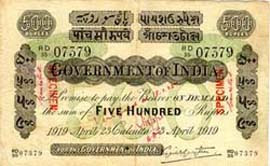
Rupees Hundered

Green Underprint - Rupees Five Hundred


Green Underprint - Rupees Five
 Rupees fifty
Rupees fifty
 Rupee One - Obverse
Rupee One - Obverse
 Rupee One -Reverse
Rupee One -Reverse
 Rupees Two and Annas Eight
Rupees Two and Annas Eight
 Rupees Fifty
Rupees Fifty
 Rupees One Thousand
Rupees One Thousand
 Rupees Ten Thousand
Rupees Ten Thousand

 Rupees One Hundred
Rupees One Hundred
 Rupees One Thousand
Rupees One Thousand
 Rupees Ten Thousand
Rupees Ten Thousand
 Rupee One Obverse
Rupee One Obverse
 Rupee One Reverse
Rupee One Reverse
 Rupees Two
Rupees Two
 George VI Profile
George VI Profile


 Rupees fifty
Rupees fifty Rupee One - Obverse
Rupee One - Obverse Rupee One -Reverse
Rupee One -Reverse Rupees Two and Annas Eight
Rupees Two and Annas Eight  Rupees Fifty
Rupees Fifty Rupees One Thousand
Rupees One Thousand Rupees Ten Thousand
Rupees Ten Thousand
Rupees Five - First Note issued by Reserve Bank of India
This was followed by Rs 10 in February, Rs 100 in March and Rs 1,000 and Rs 10,000 in June 1938.
 Rupees One Hundred
Rupees One Hundred Rupees One Thousand
Rupees One Thousand Rupees Ten Thousand
Rupees Ten Thousand Rupee One Obverse
Rupee One Obverse Rupee One Reverse
Rupee One Reverse Rupees Two
Rupees Two George VI Profile
George VI Profile
George VI Frontal
The George VI series continued till 1947 and thereafter as a frozen series till 1950 when post independence notes were issued.




















.jpg)



.jpg)

.jpg)
.jpg)
.jpg)
.jpg)








